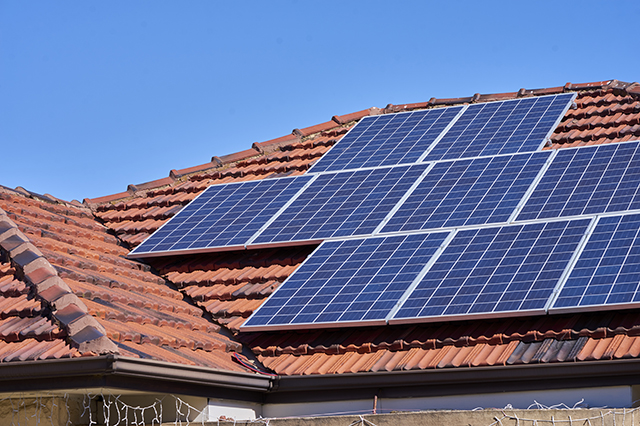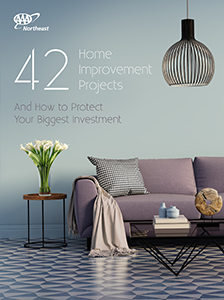The financial benefits of installing solar on your property can be significant, but the upfront cost may be keeping you from taking the next step and putting solar panels on your property. Luckily, there are a few different ways to pay for your solar panels that make it much more affordable. Here’s how to decide which makes the most sense for you.
There are four primary ways to pay for solar: cash upfront, with a loan, by renting or by leasing the solar energy system. Each method has its pros and cons, but there are three primary differences to keep in mind between each option: whether or not you’ll own your solar panels, how much you’ll pay upfront and how much you’ll pay month to month.
Upfront Purchase
The way to receive the most financial savings from investing in solar is by purchasing a solar panel system outright. For the average solar shopper, this means a purchase of around $18,000 to $27,000 upfront. Local and federal rebates and incentives can help defray this cost, with the federal investment tax credit, for instance, saving customers $5,400 to $8,100 on this investment. So the net upfront cost would be between $12,600 and 18,900.
Loan Purchase
For people interested in owning solar who would prefer not to pay for their system all at once, solar loans provide a great alternative option. Though relatively uncommon five or ten years ago, there are now a number of solar-specific loan providers who are offering very competitive options. As a result, solar loans have become very popular. If you’re interested in purchasing solar with a loan, many financiers offer $0-down options, a competitive financing rate, and a 5, 10 or 15-year term. You will still own the panels, which means that you’ll capture the electric bill savings benefits directly over time.
Leasing Solar
Not dissimilar to a solar loan, a solar lease requires no money upfront and offers a monthly payment plan. This option is primarily offered by three national solar companies – Tesla, Sunrun and Vivint. If you’ve ever leased a car, leasing solar works along similar lines: The company that installs the solar on your property maintains ownership of the solar panels, while you pay a monthly rate for the benefit of the energy produced by those panels. Leasing solar often requires a commitment to a very long payment period – generally 25 years – and you do not own the panels at the end of your contract. Financing solar this way generally delivers most of the savings benefit to the leasing company, not to you.
On the other hand, when you’re done with your loan payments, you own your solar panels outright and are essentially generating free electricity, saving against your electricity bill every month. With a solar lease, though, you continue to pay for solar electricity throughout your entire lease term and never reach a point where you generate solar electricity without a monthly payment.
Renting Solar
A unique option for solar shoppers is Tesla’s new solar renting program. The program, which was introduced in the summer of 2019, is a unique twist on the solar lease. Like a lease, the Tesla solar renting program requires no upfront cost with monthly payments instead. However, unlike a solar lease, which will lock you into a 25-year contract, the solar rental program allows you to cancel at any time, and the company will come back and remove the solar panels from your property. At present, the Tesla solar rental program is only available in six states, including Connecticut and Massachusetts in the Northeast.
Which Option Is Right for You?
There are pros and cons to each of the four primary methods of paying for a solar installation. The following table outlines how each option compares across costs, benefits and the long-term considerations of solar, such as who is responsible for any maintenance required on the solar panel system.
| Cash | Loan | Renting | Leasing | |
| Costs | ||||
| Large upfront cost | Yes | No | No | No |
| Monthly payments | No | Yes | Yes | Yes |
| Benefits | ||||
| Tax credit | Yes | Yes | No | No |
| State/Utility solar incentives | Yes | Yes | No | No |
| Reduced electricity bill | Yes | Yes | Yes | Yes |
| Increased home value | Yes | Yes | No | No |
| Long-term considerations | ||||
| Responsible for maintenance | Yes | Yes | No | No |
| Long-term contract | No | Maybe | No | Yes |
Here are the scenarios in which each option might make the most sense:
- Purchasing your panels upfront is the best option if you hope to maximize the financial savings from your solar panels.
- A solar loan is the best option if you want the benefits of owning solar panels, such as increasing your home’s value, but would prefer monthly payments to a one-time, lump sum payment.
- A solar lease may be the best option if you are most interested in reducing your monthly electricity bill with no upfront costs; however, be sure to read the contract terms carefully as solar leases sometimes come with an annual escalation that increases your monthly payments year-to-year.
- And renting solar may be the best option if you’re interested in going solar, but don’t anticipate spending the next 20 years in your home and want to see monthly bill savings right away.
To get an even better sense of what makes the most sense for your situation, there are a number of tools and resources available online to help you compare the cost and saving potential of various methods of purchasing solar, such as the EnergySage Solar Calculator.
Learn more about if solar power is right for you and your home. Before you start installing panels, talk to an insurance agent to see how you’ll be covered.
Looking for more money management tips and services? From student and auto loans to mortgages, see what a AAA financial advisor can do for you.
















